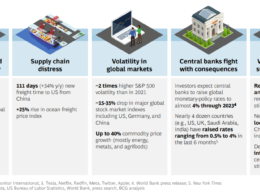health and tech
transformation institute
Joaquim Cardoso MSc
Founder and Chief Researcher & Editor
February 2, 2023
EXECUTIVE SUMMARY
The US healthcare sector is facing rising financial troubles due to increasing interest rates and labor costs, along with a heavy use of leveraged loans to fund deals, which have become unsustainable.
- A fifth of US distressed bonds come from the healthcare sector and it is the second-most represented sector in the “leveraged loan” market.
- Healthcare companies are facing the pressure of high labor costs and low reimbursement rates from the government.
- Debt levels have increased due to buyouts by private equity firms, with 95% of healthcare debt issuers now being controlled by private equity.
- The rating agencies expect ratings downgrades in 2023, with healthcare services leading the way downward.
- Outstanding debt held by the constituents of Moody’s distressed debt watchlist was nearly $65bn in December.
“Probably 80 per cent of the companies [in the sector] we think are fine,” …
“[But] there’s a growing number that are not, and that we’re worried about.”
DEEP DIVE

Debt woes mount for US healthcare sector as interest rates rise
Financial Times
February 2, 2023
US healthcare companies are sinking into debt distress as they struggle to contend with rising interest rates and labour costs after the sector borrowed heavily to fund a dealmaking boom.
A fifth of America’s distressed bonds were issued by healthcare companies — spanning services, facilities, managed care and pharmaceuticals — according to an Ice Data Services index.
The industry’s heavy representation among the riskiest US corporate borrowers has sparked warnings from ratings companies that some firms’ debts are becoming “unsustainable”.
The indications of financial trouble highlight how the sprawling US healthcare industry is sustaining pressure from broad headwinds affecting the entire economy and specific factors that are combining to make business models less tenable.

The industry has also binged on so-called leveraged loans to fund a frenzy of dealmaking as private equity firms rolled up disparate companies into larger groups.
Such loans are typically sold by lowly rated companies with high levels of debt and have floating borrowing costs, meaning their payouts to investors have soared in the past year as the Federal Reserve jacked up interest rates from near zero to more than 4 per cent in a bid to curb inflation.
Healthcare is the second most represented sector on Morningstar’s “leveraged loan” gauge, lagging only software businesses.
Healthcare is one of the industries “showing up with a fair amount of distress in the loan market and also in the high-yield bond market”, said Steve Caprio, head of US and European credit strategy at Deutsche Bank.
He said the sector has been “operating with very high leverage built upon very high profit margins.
“At a time where interest rates are now much higher, those capital structures don’t make as much sense as they used to.”

Moody’s Investors Services concurred in a report last month that “capital structures will become unsustainable” for many healthcare companies rated “B3 negative or lower” …
… — the weaker end of the credit rating spectrum — which have “high financial leverage, high levels of floating-rate debt and weak operating performance”.
Predictions of deteriorating creditworthiness are at odds with the healthcare industry’s historical reputation as a defensive sector that typically weathers economic downturns.
Caprio said the sector should no longer be seen as “recession resistant” in the current environment.
Market participants have highlighted the one-two punch of soaring workforce costs, along with pressure on the reimbursement rates provided to companies by the US government under schemes such as Medicare.
“What we’re hearing about now in the US healthcare space is labour pressure, wage pressure from employees demanding higher wages, at the same time that government reimbursement rates for some of the names in the healthcare space are lagging,” said Caprio.
Together with the weight of rising interest rates, such pressures could make it more difficult for companies to access fresh funding just as a darkening economic backdrop threatens to hamper revenue growth — paving the way for a flurry of downgrades and defaults in 2023.
“Finding lenders willing to refinance will become increasingly difficult in the year ahead as the market retrenches,” Moody’s said.

Even so, much of America’s healthcare sector is in reasonable shape, according to the rating agency.
“Probably 80 per cent of the companies [in the sector] we think are fine,” said Peter Abdill, managing director in the corporate finance group at Moody’s. “[But] there’s a growing number that are not, and that we’re worried about.”
“Probably 80 per cent of the companies [in the sector] we think are fine,” said Peter Abdill, managing director in the corporate finance group at Moody’s. “[But] there’s a growing number that are not, and that we’re worried about.”
S&P Global Ratings said in a report last week that it expects ratings downgrades to outpace upgrades again in 2023, with “speculative-grade and healthcare service providers leading the way downward”. The healthcare services subsector is “most vulnerable” because it has “the lowest margins and is most exposed to high labour costs”, S&P added.
Elevated debt levels for healthcare companies are in part a legacy of extensive dealmaking activity, with buyout firms capitalising on fragmentation in the industry. According to Moody’s, 95 per cent of healthcare debt issuers on its B3N roster — essentially a distressed debt watch list — are now controlled by private equity.
Outstanding debt held by the constituents of Moody’s B3N list stood at almost $65bn in December, up from $33bn as recently as January 2019.
The sharp escalation in total borrowings stemmed from two recent additions — Bausch Health Companies and hospital staffing group Envision Healthcare, owned by buyout firm KKR.
Today, Envision’s senior unsecured notes maturing in 2026 are trading at less than 30 cents on the dollar, a level widely associated with extreme distress.

Some companies in areas such as skilled nursing facilities and rural hospitals are making just enough money to continue operating, but could ultimately be crushed by higher interest rates, according to John McClain, portfolio manager at Brandywine Global Investment Management.
“There are a number of zombie companies in the space . . . that need to be addressed either through recapitalisation or elimination,” he said.
Originally published at https://www.ft.com on February 1, 2023.
Names Mentioned
- Peter Abdill, managing director in the corporate finance group at Moody’s
- Steve Caprio, head of US and European credit strategy at Deutsche Bank.
- John McClain, portfolio manager at Brand








